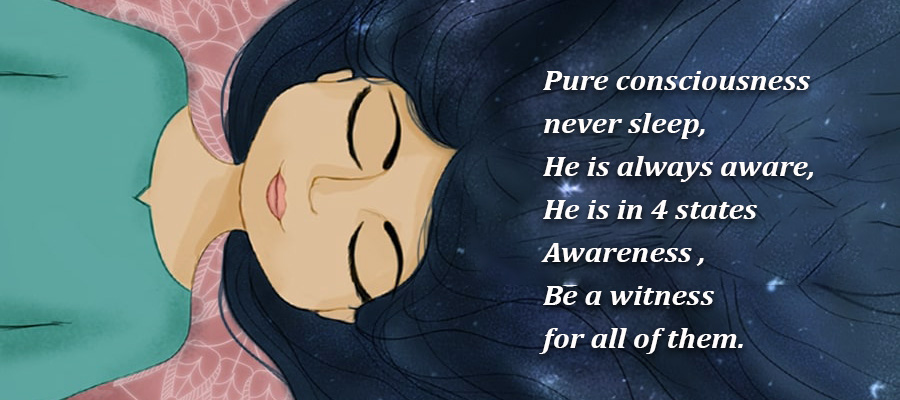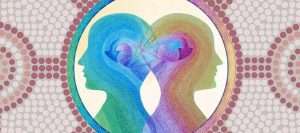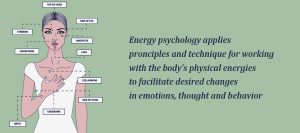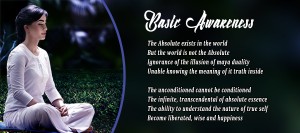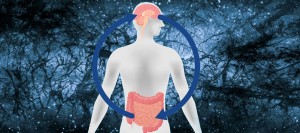- 1Mind and Prana
- 1.1Healing
- 1.2Sleep and the Home
- 2The Great Cosmic Dream
- 3Every Day as the Creation of the Entire Universe
- 4THE POWER OF CONSCIOUSNESS
- 5Three Worlds and Five Bodies
- 6SLEEP AS A SPIRITUAL DISCIPLINE
- 7Ayurvedic View of Dreams
- 8SLEEP PROBLEMS
- 8.1Why do we sleep?
- 8.2How does sleep affect memory?
- 8.3What has changed in sleep research?
- 8.4What do you measure to test brain health?
- 9NIDRA YOGA — MINDFUL SLEEP
- 10YOGA AT EACH LEVEL OF CONSCIOUSNESS
- 10.1Yoga in the Waking State
- 10.2Yoga in Deep Sleep
- 10.3Yoga in the Fourth State
- 11Natural Patterns of Sleep
- 12Dreams and the Astral World
- 13Science and the Mind
YOGA AT EACH LEVEL OF CONSCIOUSNESS
Our true self is not simply a waking self identified with a physical body. Our true Self is behind and beyond the four states. Having delved deeply into this mystery, Hinduism provides us with a clear system for perceiving and transcending the three limited levels of consciousness and practical means for attaining the fourth state, which brings direct perception of eternal reality. It is important to be aware of all aspects of ourselves and our consciousness in our waking, dreaming, deep sleep states and so on. For this purpose, we have outlined the yogas of the four states below;
Yoga in the Waking State
The yoga of wakefulness is striving to be conscious and attentive in all that we do. It is a cultivation of direct perception in which we distinguish our eternal essence of awareness from the outer forms limited in time and space. Most of us are half asleep during much of the day, falling into speculation, imagination, daydream, habit, enjoyment and loss of self-awareness, rarely connected and sustained by our inner consciousness. True wakefulness is being mindfully aware at every moment, observing the world with detachment, rather than running after it with desire. There is nothing the world can offer that can compare to the depth of awareness, perception and insight within us.
We all have our moments of clarity and wakefulness in the waking state, lucid moments that allow us to make wise decisions. But few people consciously cultivate this state.
It may sound odd, but we need to cultivate staying awake while awake, rather than drifting off into mechanical action or compulsive reaction, and getting lost in the dream of the material world. Our base emotions are largely subconscious reactions, rather than conscious responses. Fear, anger or desire are little better than dreams, unintelligent ways to interact with the world. If we examine our so-called waking state, we will find that there is little true wakefulness within it, but predominantly distracted or dull states of mind.
The yoga of the waking state is one of moment-by-moment wakefulness. All its practices are merely supports for this. There are many ways to become more aware while awake. A yogic goal is to perfect these sadhanas and carry them on to the other states of consciousness.
Chanting and meditating upon Aum is a helpful support practice to all the yogas of the four states. Chant Aum as you fall into sleep; chant Aum as you awaken in the morning. This helps us hold wakeful awareness throughout the day and carry it into dream and sleep as well.
Remembering ourselves as the witness of the waking state—with dream, deep sleep and cosmic consciousness as the deeper aspect of our nature—is a key practice, not losing ourselves to the external world, but remaining composed within. Cultivating memory overall is a strengthening aid.
Holding to a mantra throughout the day, such as Aum Namah Shivaya, helps remind us of our deeper awareness. Yet, we must energize the mantra with attention. Mere mechanical repetition can result in a loss of wakeful awareness. Most important is to remember the Deity through mantra the first thing each morning, such as with Hinduism’s many morning remembrance chants, pratar smarami.
Brahma Muhurta, the period of one to two hours before sunrise, is the ideal time for meditation. It is the time of day when we can most easily connect with the forces of cosmic consciousness, drawing the awareness behind the deep sleep state into the waking state and experiencing how the entire universe arises from Brahman as Aum.
Pranayama brings us back when our mind drifts into a lack of awareness, breathing in the deeper energy of consciousness that persists in deep sleep. The more we have such a unified and spiritualized prana, the more we can hold our awareness centered within throughout the day.
By using the senses for contemplative awareness, rather than entertainment or enjoyment, we learn to be aware of the presence of Being and the light of consciousness behind the forms of nature. This sadhana can be developed further into pratyahara, or sense withdrawal.
Cultivating a sense of the impermanence of all waking experiences, including dramatic events in our own life, helps us identify with our true Self.
Karma yoga, selfless service, allows us to imbue our actions with awareness and let go of mechanical reactions. This is particularly important if we find meditation practices difficult. Those who remain perpetually awake never die, for their wakefulness is not rooted in the physical body but in recognition of the divine presence. To achieve this requires being undistracted and concentrated in all that we do. This cannot be achieved immediately, but we can make progress every day.
Yoga in the Dream State
At the moment we fall asleep we encounter a doorway in consciousness through which we can enter into the ever-wakeful state. This we should learn to recognize. We should prepare for the moment of sleep as an opportunity to transcend our waking self and its outer reality. Then, instead of simply falling asleep, we can move into a meditative state.
To be able to move into this state of conscious sleep, it is helpful to shut down all media and electronic influences at least two hours before sleep. Go out into nature for a few minutes, chant or silently meditate, perform some rituals using ghee lamps or incense. Such practices will clear your mental field from the agitated patterns of the day. When you lie down to sleep, first voluntarily let go of the mind and hold to the inner light. Remind yourself that you are neither body nor mind, which are but your instruments.
You can also contact that doorway to the clear light of awareness at the times of sunrise, noon and sunset. The Gayatri mantra is used for that purpose, directing us not only to the light of the outer Sun but to the light of the inner Sun, the light of consciousness behind the dualities of the outer world.
A mini-waking and sleep or birth and death happen with all the different movements of our nature. This includes the opening and closing or winking of the eyes, and each breath, with its inhalation and exhalation. Yogis know how to cultivate these points of transformation, as in the fixing of the gaze or in the holding of the breath. The waking and sleep cycle is the most important of these.
In the dream state we have access to the subtle elements, or tanmatras, the creative essences behind the sensory potentials of sound, touch, sight, taste and smell. The sensory potentials of the dream state are actually much greater and more refined than those of the waking state, but require some cultivation of the mind and perception to access. The dream state provides access to worlds of subtle perception, imagination and creativity. These are great realms of art, vision, inspiration and joy. Cultivating higher sensibilities and artistic expressions can help us reach the higher levels of the dream state.
Certain occultists pursue astral travel—waking and moving in the dream state and the astral world. They realize the reality of the dream state. While they may have various psychic abilities, they can still be caught in subtle ego, illusion and desire, which are considerable in the dream realm.
There are various meditative approaches that teach us to manipulate our dreams in order to transcend the outer idea of who we are. Some yogis learn to awaken in the subtle or dream body and visit the subtle worlds for higher knowledge and experience, without being trapped in its illusions. Others seek to circumvent the dream state and go directly into formless levels of awareness beyond any imagination. Note that imagination, called vikalpa in Sanskrit, is the main mental fluctuation that yoga implores us to master.
There are two aspects of the yoga of dreaming. The first is to try to become conscious in the dream state (which usually puts our dreams to an end). This does not mean being aware in our waking ego in the dream state, but holding to the witnessing consciousness, detached from body and mind, being aware that we are dreaming. This allows us to transform our dreams into tools of deeper insight, recognizing that dreaming is but a creation of our own mind.
The second aspect of this yoga is to dream our highest spiritual dreams and aspirations, which is closely connected to bhakti yoga. It is to cultivate the higher powers of imagination, the visionary powers of the mind, to reflect a higher spiritual reality. Dream is the best state in which to dream our highest dream, which, if we go to the core of our hearts and the eternal wishes of our souls, is that of communion with the Deity in divine realms of pure energy, light and happiness. Bhakti yoga has a special resonance with the higher aspects of the dream state. Enjoying devotional music, mantra and chanting before sleep can transform the dream into a natural state of worship. Creative visualization is very helpful, particularly visualizing the Divine with our inner eye. Performing manasa puja, or mental puja, is excellent for spiritualizing the dream state. As you fall asleep, call to mind the image of the Deity and commune with it. You should pursue your highest dreams in life, which are to commune with the greater universe within our own hearts, worshiping the Divine in the form that your heart most aspires to.
Yoga in Deep Sleep
The yoga of deep sleep is primarily abiding in formless awareness, returning to the original void or state of emptiness in which everything is hidden in seed form. In deep sleep there is no objective world to be perceived, nor a separate self with which to perceive. World and self-consciousness are merged in a state of pure potential, with currents of possibilities and structures of underlying cosmic principles or dharmas. There is a mass of light, energy and vibration with only incipient movement. There is no outer or form-based bodily self. Being conscious of this root vibration is the yoga of deep sleep.
The higher, formless worlds of the causal plane can be reached through developing awareness in deep sleep. These are realms of meditation, voidness and light. We can earn access to them by cultivating a deeper peace and contentment and by learning to be a formless being, a pure mind, without the need for an external world or body. We can do so by cultivating higher principles of unity and harmony, the rule of cosmic law. One way to facilitate this is to meditate on the yantras, or geometrical forms, of the Deities, like the famous Shri Yantra.
The yoga of deep sleep happens on two levels. It begins in the waking state with the practice of deep pratyahara, or sensory concentration and withdrawal. In this way it is possible to draw the mind, prana and senses into a condition of wakeful deep sleep. One holds the awareness deep within the heart, and the outer mind and senses are shut off.
Then, during deep sleep, one strives to maintain continual awareness throughout, not as the waking personality, but as the deeper awareness behind the mind. This is the true yoga nidra, or yogic sleep.
Another important part of the yoga of deep sleep is cultivating peace and contentment in daily life, particularly the ability to surrender, relax and accept. Practicing pratyahara in the waking state aids in this. We must learn to let go of name and form, body and mind and rest in the undifferentiated state of awareness. We must accept the great mystery that true knowledge transcends the mind and that what the mind knows is just a form of darkness or ignorance that can at best merely reflect some aspect of the light. Then deep sleep can lead us into the turiya state.
Yoga in the Fourth State
The underlying practice behind the yogas of waking, dream and deep sleep is cultivating the witness consciousness, or sakshi bhava. To remain firmly in the witness state is to immediately cross over waking and sleep, time and space, birth and death. This begins with cultivating wakeful awareness, conscious dreaming and remaining aware in deep sleep.
Cultivating the witness state is also the core practice for the fourth state, but requires support practices. First, we should maintain a dharmic and conscious lifestyle, such as outlined in the yamas and niyamas of yoga practice. This includes a vegetarian diet, control of our sense and motor organs, and control of our mind and emotions. All of this is required for any serious meditation practice. Second, we must learn to sustain a moment-by-moment awareness. This begins by regular meditation practices morning and evening, mantra and certain spiritual qualities, particularly astute powers of attention, concentration and detached observation.
This leads us to the practice of Self-inquiry, tracing the I-thought to its origins in the heart. One asks the question “Who am I?” and follows its examination deep within the heart and inner consciousness. One inquires into the nature of the pure “I am” beyond the identified or objectified self of the waking state or bodily self. One then looks into the nature of the pure “I am,” beyond the self of the dream state, which holds our desires and wishes. Finally, one looks into the pure “I am” beyond the self of deep sleep, confronting the ignorance behind our lives and recognizing our true identity as pure consciousness.
The true Self we are seeking is not the self of the waking state, but the Self behind waking, dream and deep sleep. Normally we seek realization for our physical, wakeful self, which is but a dream and an illusion. True spiritual practice begins when we set the waking self and outer waking world aside as unreal and learn to look within, removing the deeper veils of consciousness.
Energizing the entire Aum vibration is a great aid in this process. Aum is the bow, our Self-awareness is the arrow, and Brahman or the transcendent state, is the target or goal, as the Mundaka Upanishad says.
Another method is total surrender to the Deity, known as Ishvara pranidhana in the Yoga Sutras, and as prapatti in later devotional thought. This can be aided by mantra or practiced purely as the highest attitude of devotion.

